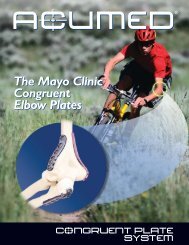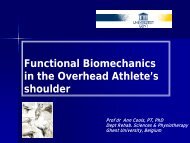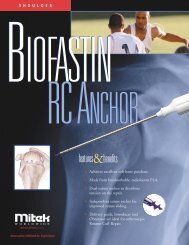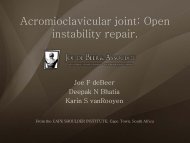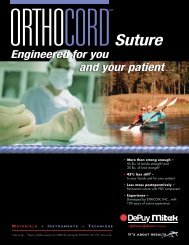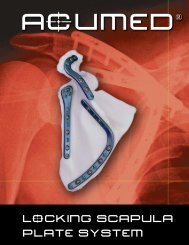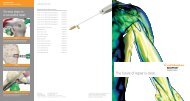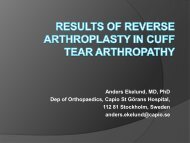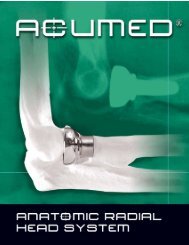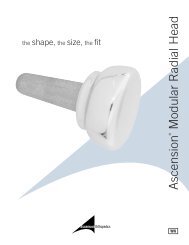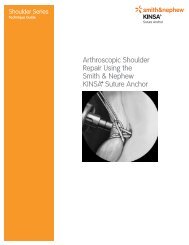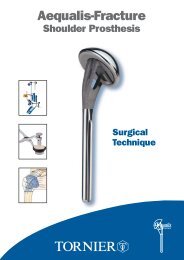DePuy CTA Hemiarthroplasty versus Traditional Hemiarthroplasty
DePuy CTA Hemiarthroplasty versus Traditional Hemiarthroplasty
DePuy CTA Hemiarthroplasty versus Traditional Hemiarthroplasty
Create successful ePaper yourself
Turn your PDF publications into a flip-book with our unique Google optimized e-Paper software.
<strong>DePuy</strong> <strong>CTA</strong> <strong>Hemiarthroplasty</strong><br />
<strong>versus</strong> <strong>Traditional</strong><br />
<strong>Hemiarthroplasty</strong><br />
Carl J. Basamania, MD, FACS<br />
The PolyClinic and Swedish<br />
Orthopaedic Institute<br />
Seattle, Washington
Cuff Tear Arthropathy Treatment<br />
Options<br />
• Rehabilitation<br />
• Rotator cuff debredment<br />
• Rotator cuff repair<br />
• Arthrodesis<br />
• Resectional arthroplasty<br />
• Total shoulder arthroplasty<br />
• Humeral head replacement<br />
• Reverse total shoulder arthroplasty
Humeral head replacement for massive<br />
rotator cuff tear
Study<br />
Arntz et<br />
al.(1993)<br />
Williams and<br />
Rockwood<br />
(1996)<br />
Field et al.<br />
(1997)<br />
Zuckerman et<br />
al. (2000)<br />
Cofield et al<br />
(2001)<br />
Number of<br />
patients<br />
Duration of<br />
Follow-up<br />
(years)<br />
No or Mild<br />
Postoperative<br />
Pain<br />
(no. of<br />
shoulders)<br />
Preop<br />
Postop.<br />
Active<br />
Elevation (deg)<br />
18 3 61% (11) 66 (44-90)<br />
112 (70-160)<br />
21 4 86% (18) 70 (0-155)<br />
120 (15-160)<br />
16 3 81% (13) 60 (40-80)<br />
100 (80-130)<br />
15 2 47% (7) 69 (20-140)<br />
86 (45-140)<br />
33 5 73% (24) 72 (30-150)<br />
91 (40-165)<br />
Successful<br />
Results based<br />
on limited<br />
goals<br />
(no. of<br />
shoulders)<br />
Not reported<br />
86% (18)<br />
63% (10)<br />
Not reported<br />
67% (22)<br />
Total/Average 103 3.4 69.2% 67.4 to 101.8<br />
(+34.4 degrees)<br />
72%
Bipolar Results<br />
Study Number of patients Duration of<br />
Follow-up (years)<br />
Preop./Postop.<br />
Active Elevation<br />
(deg)<br />
Worland et al 1997 22 28 38 - 67<br />
Sotereanos et al.<br />
2003<br />
14 27.8 30 - 88<br />
Duranthon et al<br />
2002<br />
13 28 78 - 69<br />
Total/Mean 49 27.9 48.7 – 74.7
Background<br />
• The concept of the <strong>CTA</strong> head in massive cuff tear<br />
patients with stable and possibly limited stability<br />
kinematics was:<br />
• accept the proximal migration<br />
• decrease the coefficient of friction with a<br />
smooth articular surface<br />
• articulate with both the glenoid and acromion<br />
• This should allow the deltoid and remaining<br />
muscles of the cuff to function more efficiently<br />
• More closely mimics their “new normal anatomy”
Surgical Technique
360 degree capsular release
Case Example<br />
62 y.o. Rhd male,<br />
pain x 10 yrs;<br />
now functionally<br />
fused left<br />
shoulder, VAS<br />
10/10
Subscapularis Takedown
Attaching the <strong>CTA</strong> cutting jig
Final trim
Before and After
Subscapularis Repair
Drill holes
Pass Sutures
Subscapularis Repair
Subscapularis Repair
Subscapularis Deficiency<br />
• Consider transfer of the pectoralis muscle<br />
Over conjoined tendon<br />
Under conjoined tendon
Postop
1 Year Postop
3 years post-op
Postop Care<br />
• Majority of surgeries done under regional<br />
anesthesia as outpatient with 23 hour postop<br />
observation<br />
• No sling<br />
• Cryotherapy first 2 weeks<br />
• ADL’s as tolerated permitted day of surgery<br />
• Stretching/resistance exercises at 6 weeks<br />
• Ad lib activity at 12 weeks
“Sublime Supine”<br />
• All postop rehab is<br />
done with patient in<br />
supine position<br />
• Scapular kinematics<br />
are improved<br />
• Start with pass and<br />
well arm assisted<br />
ROM<br />
• Progress to anterior<br />
deltoid strengthening<br />
• Increase resistance<br />
and inclination as<br />
tolerated
Results<br />
• 132 primaries, w/ ≥ 24 months f/u<br />
• Seebauer IA/B - IIA<br />
• 89 had previous surgery, 12 had > 2 prior surgeries<br />
• Average FF: Preop - 65 Postop – 128<br />
• Range 70 – 160<br />
• Average ER: Preop – 8 Postop - 30<br />
• Pain VAS: Preop – 9.4 Postop – 1.4<br />
• SST score: Preop – 1.1 Postop – 8.6<br />
• ASES score: Preop – 28 Postop - 76<br />
• Satisfaction: 88% rated result as good or excellent<br />
• 84% of surgeries were performed under regional<br />
anesthesia as an outpatient procedure
Results of <strong>CTA</strong> in Seebauer IIB<br />
• 23 patients<br />
• 16 failed TSA arthroplasty<br />
• Average FF: Preop - 37 Postop - 70<br />
• Pain VAS: Preop - 10 Postop – 4<br />
• Satisfaction: 12 poor, 8 fair, 3 good<br />
• Overall, poor subscapularis function correlated<br />
with poor function
To Date:<br />
• Complications:<br />
• Five postop arthrofibrosis<br />
• Tx’d with arthroscopic debredment<br />
• One acromial fracture after fall<br />
• Two subscap ruptures after falls<br />
• No progressive glenoid/acromial wear<br />
• Two revisions to Delta (subscap ruptures)<br />
• 1.5% revision rate
Failed <strong>CTA</strong> after Fall – increased<br />
superior migration due to subscap rupture<br />
Before<br />
After
Increased anterior translation on<br />
axillary after rupture<br />
Before<br />
After
Later rupture of subscap – treated<br />
with Delta reverse TSA
Two years postop<br />
• 82 year old female<br />
• Swims in lake 2 times/day
• 85 year old<br />
• Declined a Delta<br />
• Two years post-op<br />
both shoulders<br />
• Week prior to last<br />
clinic visit:<br />
• Dug a 20m<br />
drainage ditch<br />
• Cut an 6m<br />
groove in<br />
concrete with a<br />
hammer and<br />
chisel<br />
• Rebuilt his boat<br />
motor
Observations<br />
• Keys to a good <strong>CTA</strong>:<br />
• Intact or “functional” coracoacromial arch<br />
• Intact subscapularis<br />
• Proper anatomic sizing
Proper Anatomic Sizing is Key
Non-anatomic sizing
Delta or <strong>CTA</strong> Candidate?
Who Gets What???<br />
• If the patient can forward flex at least<br />
70 – 80 degrees and have an intact subscap:<br />
• They have stable kinematics<br />
• They would probably do well with a <strong>CTA</strong><br />
• If they cannot:<br />
• They may have unstable kinematics<br />
(Seebauer IIB)<br />
• They would probably do better with a Delta
<strong>CTA</strong> or Delta?<br />
• These are two almost<br />
distinctly different<br />
groups<br />
• Reverse prosthesis is<br />
probably “overkill” in<br />
patients with an intact<br />
coracoacromial arch<br />
and NO superior<br />
escape<br />
• Yes, it may do well but<br />
is it necessary?
Defect type and recommended type<br />
of prosthesis<br />
Defect-type Ia Ib IIa IIb<br />
Prosthesis <strong>CTA</strong> <strong>CTA</strong> <strong>CTA</strong><br />
?Delta ® Delta ®
There’s a time and place for both
<strong>CTA</strong> <strong>versus</strong> Reverse Arthroplasty<br />
• The Reverse shoulder should be reserved for:<br />
• Salvage cases when no other viable<br />
alternative for treatment exists<br />
• Low demand patients<br />
• Physiologically over 70 years of age<br />
• What are the “Societal costs” of a reverse TSA<br />
compared to a <strong>CTA</strong>?
Conclusion<br />
• <strong>CTA</strong> hemiarthoplasty can provide excellent<br />
results in patients with a functional<br />
subscapularis and stable kinematics<br />
• Reverse TSA should be reserved for low<br />
demand, older patients with unstable<br />
kinematics<br />
• Education and training is the key in getting<br />
better results
<strong>CTA</strong> or Delta?
Right <strong>CTA</strong>, Left Delta
Thank you!



